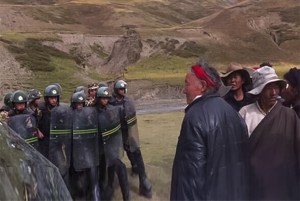Unrest in Driru County continues as Chinese authorities launched a “Rectification and Cleansing” campaign in the province last month. The 30-page campaign booklet contains instructions that all stupas, mounds, shrines and retreat buildings built after 2010 must be destroyed, as they have been declared illegal by the authorities. The document added that they must be destroyed by a specific deadline, and by the villages and monasteries who built them. If people fail to comply, the authorities will destroy the illegal monuments for them.
The document also requires all monks under the age of twelve to leave the monasteries and return to their families, and states that new admissions to monasteries will be denied. If the family refuses to take their child back, they will face a six month detention, or one to three years’ imprisonment. If Lamas and Khenpos hold the monks back, they will be punished and expelled themselves, reports Radio Free Asia.
The campaign booklet has been distributed to all monasteries and villages in Driru, with the campaign ending on October 20. Earlier this year, another handbook was issued entitled “Two laws by Peoples Government of Driru County”, featuring rules and punishments to prevent Tibetans protesting against the Chinese authorities.
Earlier this month, it was also reported that six Tibetan Monks from Drongurgon Kagyu Phelgyeling in Wathang town in Driru were arrested after removing the Chinese National flag from their monastery terrace and burning it.
Driru has seen unrest for over a year, since Chinese authorities began mining at Naglha Zamba, a sacred hill and pilgrimage site. In September 2013, Tibetans threw Chinese national flags into a nearby river instead of displaying them from their rooftops as required on Chinese National Day last year. Days later, protests were sparked by the detention of a local man, resulting in Chinese authorities opening fire at the unarmed crowd, leaving around 60 wounded. Two months later, the authorities shut down Drongna monastery and others in the region. In the three-month period of protests and unrest, 1,000 people were detained, around 600 of whom are thought to have received a programme of political “re-education”.






 Print
Print Email
Email